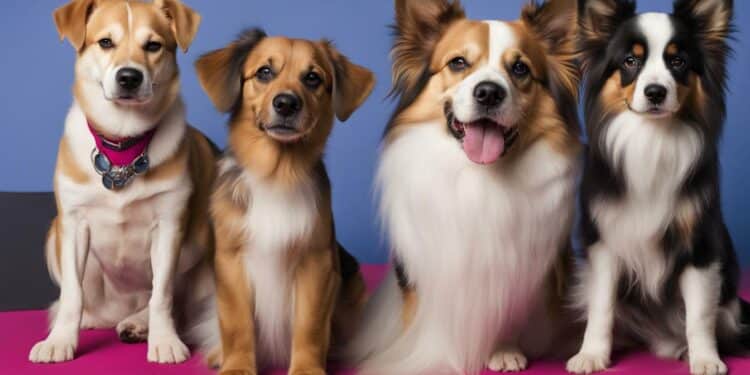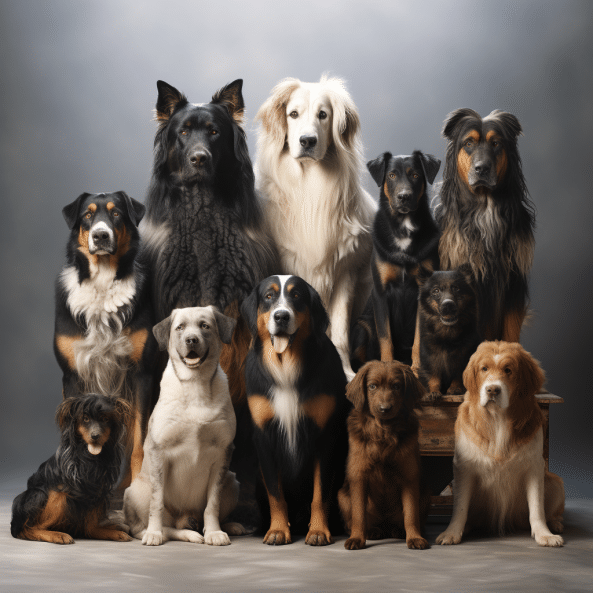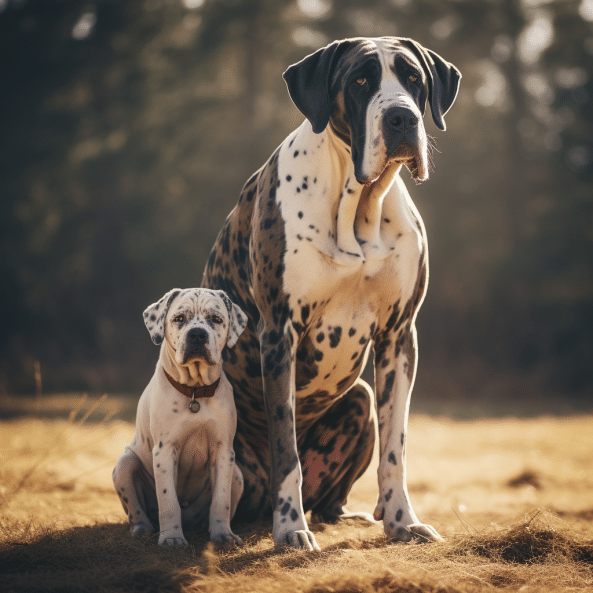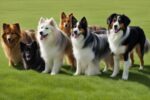Exploring the World of Large and Small Dog Breeds

Here is a full list of the top 10 biggest and smallest dog breeds. The guide will take you on an adventure as you learn about their traits, care needs, and where they rank in terms of size, whether you’re interested in the huge giants or the tiny dogs.
There are 10 big dog breeds: the Mastiff, the Boerboel, the Tosa Inu, the Saint Bernard, the Great Dane, the Leonberger, the Neapolitan Mastiff, the Newfoundland, the Anatolian Shepherd, and the Tibetan Mastiff. People love these breeds because they are big, strong, and loyal.
They are the Pomeranian, the Toy Poodle, the Toy Fox Terrier, the Biewer Terrier, the Papillon, the Chihuahua, the Russian Toy, the Russian Tsvetnaya Bolonka, the Toy American Eskimo Dog, and the Bolognese. These small breeds are known for their small size, different coat types, and different levels of activity.
It is important to note that large dog breeds require special attention in terms of development, space, expenses, and training. This guide aims to provide you with all the information you need to understand and care for these unique breeds.
Introduction to Large Dog Breeds

Large dog breeds, also known as giant breeds, are a fascinating group of dogs known for their imposing size, strength, and loyalty. These majestic canines capture the hearts of many dog lovers with their commanding presence and gentle nature. From the massive Mastiff to the elegant Great Dane, these breeds possess remarkable characteristics that make them stand out in the world of dogs.
When it comes to size, large dog breeds are in a league of their own. They tower over their smaller counterparts, with some reaching heights of over 30 inches and weights exceeding 100 pounds. This physical stature, combined with their impressive strength, makes them ideal for various roles such as guarding, protection, and working alongside humans. However, it’s important to note that their size also comes with unique care requirements.
Large dog breeds require ample space for their development and exercise needs. They thrive in homes with large yards or access to outdoor areas where they can freely roam and play. Regular exercise is crucial to keep their minds and bodies stimulated, as well as to maintain their overall well-being. Additionally, their diet should be carefully monitored and formulated to support their growth and maintain a healthy weight.
Understanding the Characteristics and Care Needs
Each large dog breed has its own set of characteristics and care needs. For example, the Mastiff, known for its imposing size and protective nature, requires a firm yet gentle owner who can establish clear boundaries and provide consistent training. On the other hand, the Saint Bernard, with its gentle and friendly demeanor, thrives in a loving and nurturing environment where it can be a loyal companion to its family.
It’s important for potential owners to research and understand the specific needs of the large dog breed they are interested in. This includes considerations such as grooming requirements, activity levels, and potential health issues that may be common to the breed. By being well-informed, individuals can ensure they are fully prepared to provide the best care and environment for their large canine companion.
| Top 10 Largest Dog Breeds |
|---|
| Mastiff |
| Boerboel |
| Tosa Inu |
| Saint Bernard |
| Great Dane |
| Leonberger |
| Neapolitan Mastiff |
| Newfoundland |
| Anatolian Shepherd |
| Tibetan Mastiff |
Large dog breeds undoubtedly leave a lasting impression with their immense size, beautiful appearance, and unwavering loyalty. As potential owners embark on their journey of welcoming a large breed into their lives, it is essential to educate themselves about the specific breed they are interested in, ensuring a harmonious and fulfilling relationship with their furry companion.
The Mastiff: An Imposing Giant
The Mastiff, a breed known for its imposing size and gentle nature, ranks among the largest dog breeds in the world. Originating from ancient times, these massive canines have a long history as guardians and protectors. With a weight that can exceed 200 pounds, the Mastiff is truly a giant among dogs.
One of the key features of the Mastiff is its incredible strength. These dogs have powerful muscles and a sturdy build, making them formidable in both appearance and presence. Despite their size, Mastiffs are known for their calm and gentle temperament, making them excellent family companions.
When it comes to caring for a Mastiff, it’s important to consider their specific needs. Due to their size, they require ample space to roam and exercise. Daily walks and playtime are essential for their physical and mental well-being. Additionally, Mastiffs have a tendency to drool and snore, so potential owners should be prepared for these traits.
In conclusion, the Mastiff stands out as one of the largest and most impressive dog breeds. With its imposing size, gentle nature, and rich history, this breed is a true giant among canines. If you’re considering adding a Mastiff to your family, be prepared for a loyal and loving companion who will undoubtedly leave a lasting impression.
The Boerboel: A Powerful Protector
The South African Boerboel is one of the largest dog breeds and powerful and protective. Boerboels are known for their strength and defending instincts. These faithful and brave canines make great family pets and protectors.
Boerboels have a huge head, broad chest, and a strong bark that can scare off intruders. Originally bred to protect farms and properties, their size and power make them a formidable force.
Understanding Boerboel demands and traits is crucial to ownership. These dogs need early socialization and training to become well-rounded and well-behaved. Since they love exercise and interaction, owners should provide them lots of mental and physical stimulation.
| Key Features of the Boerboel Breed | Description |
|---|---|
| Size | One of the largest dog breeds, males typically weigh between 150-200 pounds (68-90 kg), while females weigh around 110-150 pounds (50-68 kg). |
| Temperament | Boerboels are protective, confident, and loyal. They are known for their devotion to their families and their ability to assess threats accurately. |
| Exercise Needs | Regular exercise is essential to keep Boerboels physically and mentally stimulated. Daily walks, play sessions, and mental enrichment activities are recommended. |
| Grooming | Boerboels have a short, dense coat that requires minimal grooming. Regular brushing to remove loose hair and occasional baths are usually sufficient. |
As with any large breed, it’s crucial to ensure that you have the space, resources, and commitment necessary to meet the needs of a Boerboel. Adequate training, socialization, and healthcare are essential to raising a happy and well-adjusted dog. If you’re considering adding a Boerboel to your family, be prepared for a loyal, protective, and loving companion who will be a steadfast guardian for years to come.
Tosa Inu: A Majestic Japanese Breed
The Tosa Inu, a majestic Japanese breed, is renowned for its size, strength, and noble presence, earning it a place among the largest dog breeds. Originating in Japan, these powerful dogs were originally bred for dog fighting but have since gained popularity as loyal family companions.
The Tosa Inu exhibits a muscular build, with males weighing between 130-200 pounds and standing at 24-32 inches tall at the shoulder. Their large, imposing frame is matched by their protective nature, making them excellent guard dogs. Despite their size, Tosa Inus are known for their calm and gentle temperament, particularly towards their family members.
These regal dogs require experienced owners who can provide them with consistent training, socialization, and ample exercise. While they may be reserved with strangers, Tosa Inus are fiercely loyal and loving towards their owners. With proper care and training, they can make devoted companions and protectors.
| Key Characteristics | Key Considerations |
|---|---|
| Size: Large | Require experienced owners |
| Weight: 130-200 pounds | Need consistent training and socialization |
| Height: 24-32 inches | Require ample exercise |
| Temperament: Calm, noble, protective | Fiercely loyal to their owners |
In conclusion, the Tosa Inu is a magnificent breed that commands attention with its stately presence. With their impressive size, strength, and loyal nature, the Tosa Inu stands as one of the largest and most revered dog breeds. Potential owners should be prepared to provide these dogs with the proper care, training, and socialization they require to thrive in a loving environment.
Saint Bernard: A Gentle Giant
The Saint Bernard, known for its iconic appearance and gentle demeanor, is a lovable giant that ranks among the largest dog breeds in the world. With their massive size and kind hearts, these dogs have become beloved companions and working dogs across the globe.
The history of the Saint Bernard can be traced back to the Swiss Alps, where they were originally bred as rescue dogs. Their strength and endurance made them well-suited for pulling sleds and locating lost travelers in the snow. Today, they are more commonly found in family homes, where their gentle nature and affectionate personality make them excellent companions.
Characteristics and Temperament
Saint Bernards are known for their impressive size, with males typically weighing between 140 to 180 pounds and standing 27 to 30 inches tall at the shoulder. Their large heads are adorned with expressive eyes and ears that hang down to the sides. They have a thick double coat that provides insulation in cold weather.
Despite their intimidating size, Saint Bernards are renowned for their gentle and patient temperament. They are known to be great with children and are often described as gentle giants. They are loyal, friendly, and eager to please, making them a popular choice for families.
| Key Characteristics | Temperament | Care Needs |
|---|---|---|
|
|
|
“Saint Bernards are known for their gentle and patient temperament. They are known to be great with children and are often described as gentle giants.”
Saint Bernards must exercise to be healthy and avoid weight gain due to their size. To stay intellectually and physically active, walk and play daily. Keeping their thick coats clean and mat-free requires regular maintenance.
Saint Bernards need early and persistent training to become well-behaved family members. Intelligent canines, they learn effectively with positive reinforcement and rewards.
Saint Bernards are stately and gentle giants that provide joy and affection to any home. They’re big, yet their kindness sets them different. A devoted and caring friend with a big heart, the Saint Bernard may be the breed for you.
| Key Facts | Data |
|---|---|
| Size | Large |
| Weight | 140-180 pounds |
| Height | 27-30 inches (at the shoulder) |
| Coat Type | Thick double coat |
| Temperament | Gentle, patient, friendly |
| Exercise Needs | Regular exercise |
| Lifespan | 8-10 years |
Great Dane: The Apollo of Dogs
The Great Dane, known as the Apollo of Dogs, is a magnificent and one of the largest canine breeds. With its majestic stature and exquisite demeanor, the Great Dane always draws attention. Many families and individuals enjoy this gentle giant because of its friendly and affectionate personality.
German-born Great Danes have a long history. This large breed is kind and patient. Despite its intimidating appearance, the Great Dane is a kind and gregarious companion that bonds with its human family.
| Key Characteristics of the Great Dane | |
|---|---|
| Size: | One of the largest dog breeds, with males standing at least 30 inches tall at the shoulder and weighing between 140 to 175 pounds, while females are typically slightly smaller. |
| Temperament: | Friendly, affectionate, and patient. Great Danes are known for their gentle nature and get along well with children and other pets when properly socialized. |
| Exercise Needs: | Though they are large, Great Danes are relatively low-energy dogs. Regular exercise, such as daily walks and playtime, is important to maintain their overall health and prevent obesity. |
| Training: | Great Danes are intelligent and eager to please, making them trainable. However, their large size requires consistent and patient training methods. |
| Care Requirements: | Regular grooming, including brushing their short coat and cleaning their floppy ears, is necessary. Great Danes are prone to certain health issues, such as bloat and joint problems, so regular vet check-ups are important. |
Leonberger: A Gentle Giant from Germany
The Leonberger, hailing from Germany, is a gentle giant known for its impressive size and friendly disposition, solidifying its place among the largest dog breeds. These majestic canines possess a commanding presence that is both awe-inspiring and endearing.
The Leonberger’s striking appearance is characterized by its sturdy build, deep chest, and beautiful mane. Their thick, double coat provides protection in various weather conditions and adds to their regal charm. With their expressive eyes and gentle expression, these dogs capture the hearts of all who encounter them.
Despite their massive size, Leonbergers are renowned for their calm and affectionate nature. They are devoted family dogs, renowned for their loyalty and patience, making them excellent companions and guardians. While they may appear intimidating, their inherent sweetness and gentle temperament make them great with children and other pets.
| Leonberger Facts | |
|---|---|
| Origin: | Germany |
| Size: | Large |
| Coat Type: | Double coat (long and water-resistant) |
| Temperament: | Friendly, gentle, and loyal |
| Activity Level: | Moderate |
The Leonberger is an ideal choice for families seeking a big, lovable companion. Their size demands proper care, including regular exercise, a balanced diet, and routine grooming to keep their magnificent coats in optimal condition. As with any large breed, early socialization and consistent training are essential to ensure they grow into well-behaved and obedient dogs.
Overall, the Leonberger’s combination of size, beauty, and gentle nature makes them a remarkable breed that brings joy and love to any household lucky enough to have them as part of their family.
Neapolitan Mastiff: A Wrinkled Protector
The Neapolitan Mastiff, with its distinctive wrinkles and massive build, is a formidable and loyal breed that ranks among the largest dog breeds. Originating from Italy, this ancient breed has a history dating back thousands of years, where it was originally bred for guarding and protecting homes and properties. Today, the Neapolitan Mastiff continues to excel in its role as a protector, making it a popular choice among dog enthusiasts seeking a loyal and powerful companion.
What sets the Neapolitan Mastiff apart is its physical appearance. With loose skin and deep wrinkles covering its body, this breed has a unique and unforgettable presence. Its muscular build, massive head, and strong jaws further contribute to its imposing stature. These characteristics, combined with its protective instincts, make the Neapolitan Mastiff a breed to be reckoned with.
While the Neapolitan Mastiff may look intimidating, it is known for its gentle and affectionate nature, particularly towards its family members. This breed thrives on love and attention, forming strong bonds with its owners and often displaying a natural instinct to protect its loved ones. However, due to its size and protective nature, early socialization and proper training are essential to ensure a well-behaved and confident Neapolitan Mastiff.
In conclusion, the Neapolitan Mastiff is an impressive breed that belongs to the largest dog breeds in the world. Its unique physical features, loyal temperament, and protective nature make it a popular choice for those seeking a formidable companion and protector. However, potential owners should be aware of the breed’s specific needs, including adequate exercise, socialization, and training, to ensure a harmonious relationship with this majestic and devoted breed.
Newfoundland: A Gentle Water Dog
The Newfoundland is one of the largest dog breeds in the world, yet it is also one of the most beloved and loyal. These large, docile animals are wonderful pets, especially for families with young children because of their size and strength.
Fishing dogs were the ancestors of this breed. They were used to help with search and rescue at sea. Because Newfoundlands naturally like water sports and can swim well thanks to their webbed feet and thick double coats, they are often just called “Newfies.”
Even though they are very big, Newfoundlands are known for being friendly and forgiving. Their calm personality and good behavior around kids and other pets make them a great choice for families. Because they are naturally loyal and protective, they often help people who are in danger.
When it comes to grooming, it’s important to note that Newfoundlands have a thick double coat that requires regular maintenance to keep it clean and tangle-free. Their coat colors can vary, with black, brown, gray, and landseer (black and white) being the most common. Regular brushing and occasional bathing are essential to keep their coat healthy and prevent matting.
| Key Facts | Breed Characteristics |
|---|---|
| Size: | Very large |
| Weight: | 110-150 pounds (males), 99-120 pounds (females) |
| Coat Type: | Double coat, long and thick |
| Activity Level: | Moderate |
| Lifespan: | 8-10 years |
Overall, the Newfoundland is a remarkable breed that embodies both gentleness and strength. Their imposing size, loyalty, and friendly nature make them a wonderful addition to any family. However, it’s important to consider their specific care needs, including regular grooming and exercise, before bringing a Newfoundland into your home.
Anatolian Shepherd: A Formidable Guardian
The Anatolian Shepherd is known for being a strong guard dog. It is one of the biggest and most loyal dog breeds. This beautiful breed from Turkey was used to protect animals from wild animals, and it is known for being loyal and helpful.
Male Anatolian Shepherds weigh 110 to 150 pounds and stand 27 to 29 inches at the shoulder. Females weigh 80–120 pounds and measure 25–27 inches. Their huge stature, powerful body, and strong bones make them outstanding.
As guardians, Anatolian Shepherds must be calm and confident in addition to their physical traits. They are smart, autonomous, and can act quickly in perilous situations. In addition to their human families, they defend other creatures and property.
Training and socializing Anatolian Shepherds requires rigorous but gentle handling. Establishing limits and raising well-rounded dogs requires early and continuous training. Though aloof with strangers, they are fiercely loyal to family. Their short to medium-length hair needs regular brushing to be clean and healthy.
Anatolian Shepherds are large and faithful, thus they deserve respect and concern. Their well-being requires space, mental stimulation, and sociability. They can be loving, loyal pets who protect and stay by their owners’ sides with proper training and care.
| Key Characteristics | Size | Weight | Coat Type |
|---|---|---|---|
| Guarding abilities, loyalty, protective instincts | 27-29 inches (males), 25-27 inches (females) | 110-150 pounds (males), 80-120 pounds (females) | Short to medium-length hair, low-maintenance |
Tibetan Mastiff: A Mystical Giant
Dog breeds like the Tibetan Mastiff are large and elegant. It may have come from a mythological beast with a fascinating past. Tibetan Plateau breeders created these lovely dogs. They have been respected for centuries for defending houses, animals, and monasteries.
The Tibetan Mastiff draws attention with its huge build and noble demeanor. Males can weigh 150 pounds (68 kilograms) and stand 28 inches (71 cm) at the shoulder, while females are smaller but still powerful. Their dense black, brown, or gold double coats protect them from the severe Himalayan climate.
Loyal and independent Tibetan Mastiffs make great guards. Their instincts make them vigilant guardians of their family and territory. However, adequate socialization and training are essential to balance their protectiveness and keep them sociable with trusted people.
| Key Facts | Description |
|---|---|
| Size | One of the largest dog breeds, with males weighing up to 150 pounds (68 kilograms) and standing as tall as 28 inches (71 centimeters) at the shoulder. |
| Coat | Dense double coat that can come in various colors, providing protection against the cold. |
| Temperament | Loyal, independent, and protective. Requires proper socialization and training to ensure a well-balanced temperament. |
| Exercise Needs | Moderate exercise requirements. Daily walks and mental stimulation are important to keep them healthy and happy. |
| Special Considerations | Tibetan Mastiffs are known to be independent thinkers and may exhibit a stubborn streak. They also have a strong instinct to protect, so proper boundaries and socialization are essential. |
Because of its large size and protective nature, the Tibetan Mastiff may not be right for everyone. But those who care for it will be repaid with a loyal and majestic canine friend. Potential owners should know, though, that this breed comes with a lot of responsibilities, such as making sure they get enough exercise, room, and training to stay healthy.
Introduction to Small Dog Breeds
On the opposite end of the size spectrum, small dog breeds have their own charm and unique characteristics, offering companionship in pint-sized packages. From adorable fluff balls to elegant miniatures, these tiny dogs bring joy and love into our lives.
Small dog breeds come in a variety of shapes, sizes, and coat types. Whether you’re looking for a hypoallergenic dog with minimal shedding or a long-haired companion, there’s a small breed that suits your preferences.
Despite their small stature, these dogs have big personalities and endless energy. They may be tiny, but they make up for it with their zest for life and playful nature. Whether they’re playing fetch, going for walks, or simply snuggling up on your lap, small dog breeds are always ready for adventure.
It’s important to note that owning a small breed comes with its own set of considerations. These dogs might require extra care in terms of training, socialization, and exercise to keep them happy and healthy. Additionally, their small size makes them more vulnerable to certain health issues, so regular vet visits are crucial.
Coat Types in Small Dog Breeds
| Coat Type | Description |
|---|---|
| Short-haired | These breeds have sleek and low-maintenance coats that require minimal grooming. |
| Long-haired | These breeds have luxurious and voluminous coats that require regular brushing and occasional grooming. |
| Wire-haired | These breeds have coarse and rough coats that need regular stripping or hand-stripping to maintain their appearance. |
| Curly-haired | These breeds have tight and curly coats that are hypoallergenic and require regular grooming to prevent matting. |
Whether you prefer a short-haired, long-haired, wire-haired, or curly-haired dog, there’s a small breed that fits your desired coat type.
So, if you’re looking for a compact canine companion with a big heart, consider welcoming a small dog breed into your home. Their loyalty, love, and undeniable cuteness will bring endless joy to your life.
The Pomeranian: A Fluffy Companion
The Pomeranian, with its fluffy coat and vibrant personality, is a beloved small breed that captures hearts with its charm and cute appearance. This tiny dog, weighing in at just 3 to 7 pounds, makes up for its small size with an abundance of energy and a playful nature. Pomeranian dogs are known for their unique double coat, which comes in many colors and needs to be brushed often to stay fluffy.
Despite their small stature, Pomeranians have big personalities. They are intelligent, curious, and often fearless, unafraid to take on dogs much larger than themselves. They are also highly extroverted and enjoy being the center of attention, making them a delightful companion for individuals and families alike.
When it comes to activity levels, Pomeranians are not as demanding as some larger breeds but still require regular exercise to stay healthy and happy. Daily walks and interactive playtime are essential to keep them mentally stimulated and prevent boredom. They are small enough that apartment life is manageable for them, provided they get enough exercise and stimulation.
Summary
- Pomeranians are little, fluffy dogs known for their endearing nature and lively spirit.
- They have a distinctive double coat that comes in various colors and requires regular grooming.
- Pomeranians are intelligent, extroverted, and enjoy being the center of attention.
- They have moderate activity levels and require regular exercise to stay healthy and mentally stimulated.
| Traits | Details |
|---|---|
| Size | Small, weighing 3 to 7 pounds |
| Coat | Double coat in various colors, requires regular grooming |
| Personality | Intelligent, curious, extroverted |
| Activity Levels | Moderate exercise needs, daily walks and playtime |
Toy Poodle: An Elegant Miniature
The Toy Poodle, renowned for its elegance and intelligence, is a miniature breed that ranks among the smallest and most beloved dog breeds worldwide. With its distinctive curly coat and charming appearance, the Toy Poodle captures the hearts of dog lovers everywhere.
Toy Poodles may be little, but their enormous personality make up for their diminutive stature. They are highly intelligent and quick learners, making them an ideal choice for obedience training and various dog sports. Their intelligence also makes them adaptable and capable of forming strong bonds with their owners.
Toy Poodles come in a wide range of coat colors and styles. Their hypoallergenic, non-shedding hair allows for a wide variety of styles and colors, from the simple “puppy cut” to the most elaborate show trims.This adaptability allows Toy Poodle owners to show off their dogs’ individuality through their fashionable attire.
While their size may be small, Toy Poodles have an abundance of energy and require regular exercise to stay happy and healthy. Daily walks, playtime, and mental stimulation are essential to prevent boredom and ensure their well-being. Despite their energetic nature, Toy Poodles are also content to curl up on the couch with their owners, making them excellent companions for individuals or families living in apartments or smaller spaces.
| Key Points about Toy Poodles: |
|---|
| Small size, beloved miniature breed |
| Elegant appearance with a curly coat |
| Highly intelligent and trainable |
| Adaptable and adaptable to different living environments |
| Variety of coat styles and colors to choose from |
| Requires regular exercise and mental stimulation |
Conclusion
This guide lists the world’s biggest and smallest dog types and talks about their unique traits, care needs, and rankings. It’s an interesting read. Think about what the giants or the little friends need before you bring them into your home, no matter what you decide.
Some of the 10 biggest dog breeds are the Mastiff, the Boerboel, the Tosa Inu, the Saint Bernard, the Great Dane, the Leonberger, the Neapolitan Mastiff, the Newfoundland, the Anatolian Shepherd, and the Tibetan Mastiff. People say that all of these dogs are big, strong, and loyal. These wonderful breeds have special needs when it comes to housing, money, training, and meeting new people when they are young.
On the other end of the size spectrum, the top 10 smallest dog breeds, such as the Pomeranian, Toy Poodle, Toy Fox Terrier, Biewer Terrier, Papillon, Chihuahua, Russian Toy, Russian Tsvetnaya Bolonka, Toy American Eskimo Dog, and Bolognese, enchant us with their tiny size, variety of coat types, and different activity levels.
When choosing a dog, it’s essential to consider your lifestyle, living situation, and ability to meet the needs of the breed. No matter what kind of dog you choose—a gentle giant or a tiny friend—they will bring happiness and friendship into your life as long as you meet their needs.

FAQ Largest Dog Breeds
Q: What are the top 10 largest dog breeds?
A: The top 10 largest dog breeds include the Mastiff, Boerboel, Tosa Inu, Saint Bernard, Great Dane, Leonberger, Neapolitan Mastiff, Newfoundland, Anatolian Shepherd, and Tibetan Mastiff.
Q: What are the top 10 smallest dog breeds?
A: The top 10 smallest dog breeds include the Pomeranian, Toy Poodle, Toy Fox Terrier, Biewer Terrier, Papillon, Chihuahua, Russian Toy, Russian Tsvetnaya Bolonka, Toy American Eskimo Dog, and Bolognese.
Q: What are the characteristics of large dog breeds?
A: People love large dog breeds because they are big, strong, and loyal. They require special attention in terms of development, space, expenses, and training.
Q: What are the characteristics of small dog breeds?
A: Small-sized dog breeds can vary greatly in energy level, coat style, and size.They have specific care requirements and considerations.






